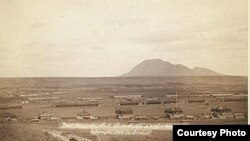FORT MEADE, South Dakota — "The Star Spangled Banner" plays when an American wins at the Olympics, is a favorite at Gospel concerts, and is routinely played at the start of every American baseball game.
What many don't know is that a remote outpost in the American West played a key role in elevating the patriotic song into the country's national anthem.
Historically, "The Star Spangled Banner" is associated with Fort McHenry in Baltimore Harbor, where the 1814 British bombardment of the fort prompted Francis Scott Key to write the song's lyrics.
But it was at another fort, in the Great Plains state of South Dakota, where the song was first played at official occasions.
Fort Meade was built in 1878 to protect settlements in the northern Black Hills, especially the gold-mining town of Deadwood.
During its early years, the fort was garrisoned by various U.S. Army units, including the 8th Cavalry. In 1892, a new commander was assigned to the post and, according to Fort Meade Museum director Randy Bender, Col. Caleb Carlton arrived with a personal mission.
“This had been a topic that he and his wife had discussed many times," Bender says, "…the fact that all these other countries had their national airs that they would play at official occasions and America had none. His wife, Sadie, was actually the one who suggested 'The Star Spangled Banner' would be a good one, because of the unusual circumstances that it had been written under, the respect that it showed for the flag and Carlton agreed with her.”
So he issued an order requiring that 'The Star Spangled Banner' be played each evening at the retreat ceremony, when the flag is lowered.
“Traditionally, all the soldiers or sailors would muster at 1700 [5p.m.], the end of the day, and it gives the soldiers the opportunity to pay their respects to the colors,” says Command Sgt. Maj. Patrick Couser, who serves with the South Dakota Army National Guard.
He says the significance of the retreat ceremony, then and now, can’t be overstated.
"We are directed...if you cannot see the colors, you face and salute the music," Couser says. "Either way, it’s the same intent. Just think about all the blood and the honor that goes into that beautiful flag, and what it stands for, and all the people that shed their blood so we have the freedoms that we do.”
It’s with that same sense of respect that Carlton directed "The Star Spangled Banner" be the last song played whenever the fort’s band performed. The colonel also ordered all persons present to rise and salute, or men to remove their hats if they were civilians.
In a 1914 letter to the mayor of Baltimore, Carlton explained song's history at Fort Meade and noted that the governors of South Dakota and Pennsylvania, along with the Secretary of War and military commanders around the country, had, over time, become aware of what he had begun.
Congress did not make "The Star Spangled Banner" the national anthem until 17 years after Carlton’s letter, and only then at the urging of renowned bandmaster John Philip Sousa. But Library of Congress music specialist Loras Schissel says there’s no escaping the fact that the actions of Fort Meade’s commander contributed to the song’s selection.
"I think they were part of a movement to make 'The Star Spangled Banner' the piece that, when people would hear it, they’d stand up and popularizing this song as a tune that, musically, meant something special to America,” Schissel says.
Today, as South Dakota’s 196th National Guard Regiment conducts the modern Retreat ceremony at Fort Meade, museum director Bender is pleased the same respect is given to the flag now as was shown in 1892.
What many don't know is that a remote outpost in the American West played a key role in elevating the patriotic song into the country's national anthem.
Historically, "The Star Spangled Banner" is associated with Fort McHenry in Baltimore Harbor, where the 1814 British bombardment of the fort prompted Francis Scott Key to write the song's lyrics.
But it was at another fort, in the Great Plains state of South Dakota, where the song was first played at official occasions.
Fort Meade was built in 1878 to protect settlements in the northern Black Hills, especially the gold-mining town of Deadwood.
During its early years, the fort was garrisoned by various U.S. Army units, including the 8th Cavalry. In 1892, a new commander was assigned to the post and, according to Fort Meade Museum director Randy Bender, Col. Caleb Carlton arrived with a personal mission.
“This had been a topic that he and his wife had discussed many times," Bender says, "…the fact that all these other countries had their national airs that they would play at official occasions and America had none. His wife, Sadie, was actually the one who suggested 'The Star Spangled Banner' would be a good one, because of the unusual circumstances that it had been written under, the respect that it showed for the flag and Carlton agreed with her.”
So he issued an order requiring that 'The Star Spangled Banner' be played each evening at the retreat ceremony, when the flag is lowered.
“Traditionally, all the soldiers or sailors would muster at 1700 [5p.m.], the end of the day, and it gives the soldiers the opportunity to pay their respects to the colors,” says Command Sgt. Maj. Patrick Couser, who serves with the South Dakota Army National Guard.
He says the significance of the retreat ceremony, then and now, can’t be overstated.
"We are directed...if you cannot see the colors, you face and salute the music," Couser says. "Either way, it’s the same intent. Just think about all the blood and the honor that goes into that beautiful flag, and what it stands for, and all the people that shed their blood so we have the freedoms that we do.”
It’s with that same sense of respect that Carlton directed "The Star Spangled Banner" be the last song played whenever the fort’s band performed. The colonel also ordered all persons present to rise and salute, or men to remove their hats if they were civilians.
In a 1914 letter to the mayor of Baltimore, Carlton explained song's history at Fort Meade and noted that the governors of South Dakota and Pennsylvania, along with the Secretary of War and military commanders around the country, had, over time, become aware of what he had begun.
Congress did not make "The Star Spangled Banner" the national anthem until 17 years after Carlton’s letter, and only then at the urging of renowned bandmaster John Philip Sousa. But Library of Congress music specialist Loras Schissel says there’s no escaping the fact that the actions of Fort Meade’s commander contributed to the song’s selection.
"I think they were part of a movement to make 'The Star Spangled Banner' the piece that, when people would hear it, they’d stand up and popularizing this song as a tune that, musically, meant something special to America,” Schissel says.
Today, as South Dakota’s 196th National Guard Regiment conducts the modern Retreat ceremony at Fort Meade, museum director Bender is pleased the same respect is given to the flag now as was shown in 1892.













